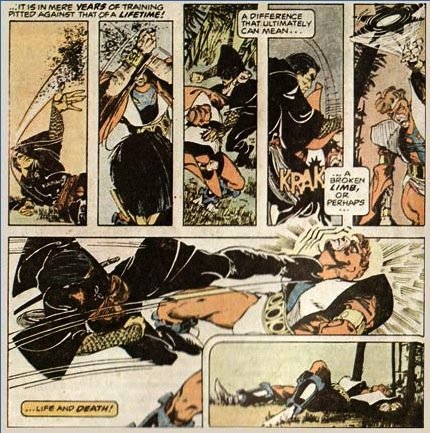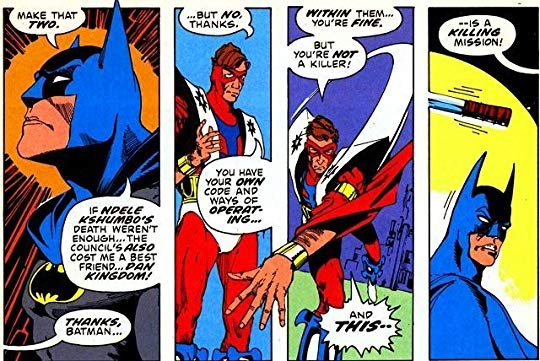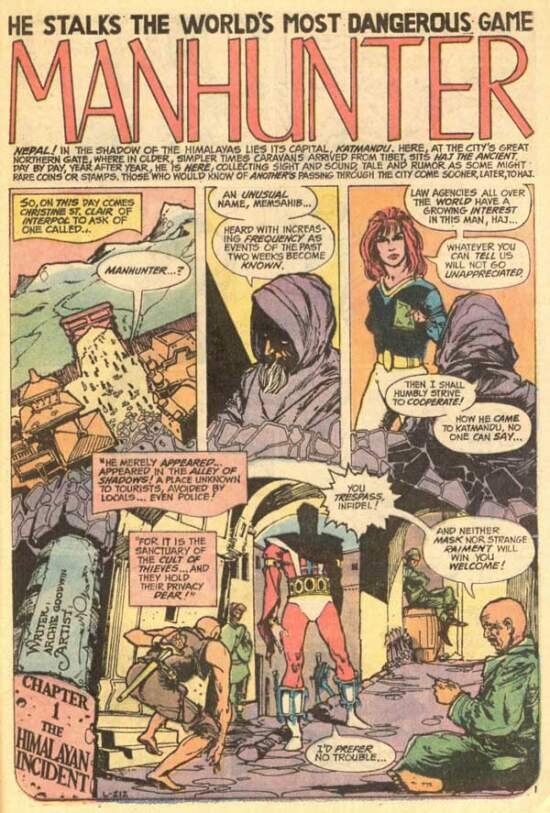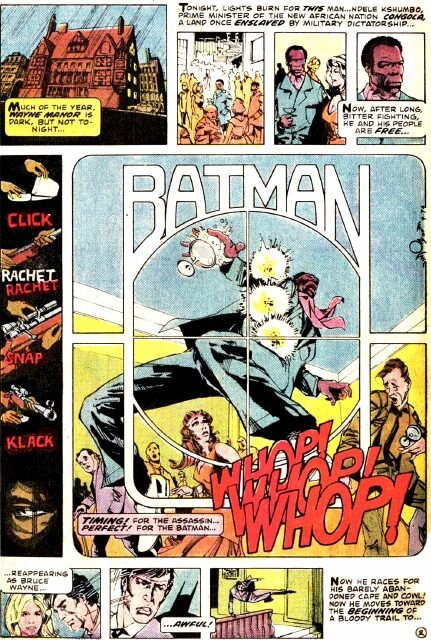DC Comics, 1973
Writer: Archie Goodwin
Artist: Walt Simonson
This is the third review of comics from the genre of espionage (for want of a better term, our “spy comics week”). We turn back almost fifty years to a revered classic, Manhunter, written by Archie Goodwin and with art by Walt Simonson.
This is a title which might not be immediately obvious as from the espionage genre. The last chapter of the seven-part series features one of American publisher DC Comics’ most iconic superheroes, Batman, for example. The title character is dressed in a flamboyant red suit and wears a superhero mask. The villains teleport. There are clones, and a helmet which fires blasts of radiation. And, best of all, there is a brainwashed ninja.

Despite these indicia of the high drama of superheroes, Manhunter is in many ways one of the best espionage comics. It is gritty and fast. The protagonists use guns. At least one of them is morally ambiguous – an African arms dealer. The title character himself has no qualms about the use of deadly force to achieve his objectives, most often at close range using knives. In the very first chapter, Manhunter’s actions clearly demonstrate that he is an assassin, willing to blow-up cars to achieve his objectives. In the very last chapter, Batman is dumped from Manhunter’s raiding party, because Batman does not have the propensity to murder.

It is not traditional superhero fare, and has many qualities that remind a reader of a war title: firearms, a grubby brawl in a cathedral, gunshot wounds, and a sense of desperation by all parties.

The espionage component comes into the title at several junctures. The action does not take place in some fictional American city, but instead dances around from Nepal to Japan to Turkey, with the landscapes meticulously rendered by Mr Simonson. The reader is taken on a world tour of danger and intrigue. It is by its backdrops an international story, with international ramifications.

In terms of plot, Manhunter seeks to bring down a cabal called The Council, which has a dark agenda of interference in global affairs. One of the characters, Christine St. Clair, is an Interpol agent who is investigating Manhunter’s spree of violence. Christine’s father is a very senior Interpol official. When St. Clair defies the Council and refuses to kill his daughter, he is shot dead in the street by an unseen assassin. (Mr Simonson, who at this stage was only starting his illustrious career, places the reader in the perspective of the murderer – St. Clair is a grainy figure walking in the gloom and fearful of retribution, he grows larger as he approaches us, and then looks at us in panic with both hands raised. There is a flash of light and the sound of a shot, and then nothing but black. The reader becomes involved as a participant in the action.)
The sense of speed is a consequence of both Mr Goodwin’s use of jammed commentary boxes – long and elaborate spiels, written with a sense of intrigue (as seen above, in the introductory page to the first chapter, entitled “The Himalayan Incident”) – coupled with Mr Simonson’s artistic dynamism and dense lay-outs, as seen below:

The grittiest part of the story is, perhaps, the conclusion, entitled “Gotterdammerung” (which we have visited before – see https://worldcomicbookreview.com/2018/12/13/operation-boom-1-3-v-detective-comics-443-gotterdammerung-comparative-review/ ). Manhunter dies in a suicide blast. This was extraordinary for a story published by DC Comics. In the superhero tradition, the heroes might have torn capes and bloodied lips, but always survive: the villains go to jail.
Why cram an international espionage story into a superhero comic? We think the prevailing political environment encouraged it:
1. In 1972, the world witnessed the Israeli Bangkok embassy hostage crisis, a raid by Palestinian militants on the Israeli embassy building in Bangkok in which the militants held six Israeli embassy staff hostage.
2. In 1972, US President Richard Nixon visited the People’s Republic of China, in a meeting secretly brokered by a man of international intrigue and realpolitik diplomacy, US Secretary Henry Kissinger.
3. A Palestinian attack during the 1972 Summer Olympics in Munich, West Germany involved the capture and execution of eleven Israeli Olympic team members. The Israeli secret service agency, Mossad, initiated a program of revenge called Operation: Wrath of God. The first Israeli assassination occurred on October 16, 1972, in Rome. Shootings and bombings of Palestinians suspected of participating in the attack continued throughout 1973.
We see very similar events play out, particularly with the targeted bombings, in the first chapter of Manhunter. In interviews about the title, both Mr Goodwin and Mr Simonson talk about the influence of martial arts pop culture upon the storyline. But there can be little doubt that they were also influenced by both the high profile operations being followed in the press, as well as what was otherwise happening in film. The movie The Day of the Jackal was released in May 1973, and involved a plot to kill President Charles de Gaulle by a group who believe de Gaulle betrayed France by permitting Algerian independence. The group hire a man known only as The Jackal, an enigmatic assassin. A Parisian police detective tries to solve the mystery of the Jackal’s identity, in an exercise which is very reminiscent of Christine St. Clair’s efforts to find and verify the identity of Manhunter. Mr Goodwin and Mr Simonson were hardly the only entertainment industry participants to be swept up in the intrigue of contemporary affairs, and were also influenced by these other forms of media.

On any objective view the high water mark of veteran writer Mr Goodwin’s career. It is well-known that the story was a merely backfill for a Batman title, Detective Comics, beginning with issue #437, and consisted only of seven short episodes (possibly contribution to the velocity), and the final single issue conclusion contained in Detective Comics #443. Notwithstanding its short life, the series won a plethora of industry awards. It is one of the medium’s best espionage stories.

